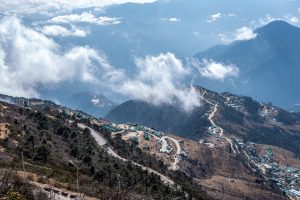There has been another clash between Indian and Chinese forces along their disputed border, this time in the eastern part of the border. The two sides have been in an active confrontation at the Galwan river valley in the Ladakh region for more than two years now.
The fresh clashes between the Indian Army and Chinese People’s Liberation Army (PLA) took place near Tawang in the northeastern Indian state of Arunachal Pradesh. The clashes occurred along the mountainous Yangtze region of eastern Tawang on December 9, with soldiers on both sides sustaining injuries, some seriously, according to media reports. There were reportedly about 600 PLA personnel patrolling along the region when the incident took place.
There is a lack of mutual clarity on where the Line of Actual Control (LAC) that separates the two sides is. As such, both Indian and Chinese troops have been patrolling based on their perceptions of the LAC, and this has resulted in clashes even before the most recent incident. For example, there was a similar incident in October 2021 when a sizeable number of Chinese troops were on a patrol in the Yangtze region. In that instance, the Chinese soldiers were detained by the Indian side for a few hours before being released. Therefore, it is not entirely unusual for these kinds of minor face-offs to happen but given the state of overall political and military relations, the potential for these incidents to get out of hand is high.
The December 9 clash is the first major incident since the Galwan clash on June 15, 2020, though at this early point, it appears to have been a less serious incident. In Galwan, 20 Indian troops and at least four PLA personnel were killed.
An Indian Ministry of Defense statement on the December 9 incident said that due to the “differing perception” of where the LAC is, there was a “face-off [that] led to minor injuries to few personnel from both sides.” There is no clarity on the number of personnel injured but, quoting multiple sources, one Indian media report said, “around 20 Indian soldiers and a much higher number on the Chinese side were injured.” The incident did not lead to any further escalation and according to the Ministry statement, the two sides “immediately disengaged from the area” and the Indian military commander in the area held a meeting with his Chinese counterpart “to discuss the issue in accordance with structured mechanisms to restore peace and tranquillity.”
India divides the Sino-Indian border — or the LAC — into three sectors. The western sector abuts the Indian territory of Ladakh, while the middle sector borders the Indian states of Himachal Pradesh and Uttarakhand and the eastern sector borders the state of Arunachal Pradesh. Most of the PLA intrusions in recent years have been in the western sector, but there have been many PLA transgressions into the eastern and middle sectors as well. For instance, according to New Delhi, even over the last two years there have been increasing instances where the PLA soldiers have been intruding in large numbers to places such as Barahoti in Uttarakhand in the middle sector.
The Indian Army reportedly acknowledged the challenge and spoke of the “need for better operational synergy between the Army and the Indo-Tibetan Border Police (ITBP)” — an Indian paramilitary force that comes under the Home Ministry rather than the Defense Ministry — so as to prevent Galwan-like clashes from happening. Army officials acknowledged that existing synergy between the two is “severely lacking.”
This is amidst a long-standing debate as to which of the two agencies should have the lead role in managing the LAC. The government is apparently looking at giving a larger role to the ITBP in managing the LAC, and the army is to be responsible for border defense. But security analysts such as Lt. Gen. D. S. Hooda make a strong case for placing the ITBP under the Indian Army’s control for better border management. He argues that though the ITBP is responsible for the LAC, the army has been playing the lead role in managing the border; army officials are the lead players in all the meetings with the Chinese counterparts at the LAC and, of course, border crises are handled by the army.
Given the overall state of affairs on the border and bilateral relations, the Indian Army has become more vigilant on the evolving situation across the LAC, with improved surveillance capabilities using a mix of technologies including “satellites, long-range unmanned aerial vehicles, high-tech intelligence, surveillance and reconnaissance (ISR) systems, superior network of radars and modern night vision systems.” Additionally, the Indian Army’s Infantry battalions protecting the LAC in Arunachal Pradesh are equipped with new weapons enhancing the combat capability mix, with upgrades including light machine guns, assault rifles, rocket launchers, unmanned aerial vehicles, all-terrain vehicles and high-tech surveillance gear. The government has also fast-tracked the construction of helipads for U.S.-built Chinook helicopters, capable of carrying the army’s latest M777 howitzers to the bases along the border.
India has also been beefing up its infrastructure along the Sino-Indian border areas, with a big emphasis on Arunachal Pradesh. Recently, the government announced a number of different connectivity projects, of which Arunachal Pradesh bagged the biggest share. The most significant is the Arunachal Frontier Highway, a 2000 kilometer road that will run parallel to the LAC. When the idea was first mooted about a decade back, the cost was thought to be around $6.5 billion for just this highway. It is sure to be much higher now.
These clashes at the border are driving India to enhance its border infrastructure. At the same time, they are also becoming a source of tension with China, which seeks to stop India from matching China’s own infrastructure development at the border. India is unlikely to relent. With two well-entrenched armies eyeball to eyeball, the likelihood of a crisis spiraling out of control is an ever-present danger.
































